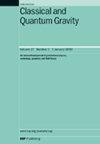An asymptotic systems approach for the good–bad–ugly model with application to general relativity
IF 3.6
3区 物理与天体物理
Q2 ASTRONOMY & ASTROPHYSICS
引用次数: 0
Abstract
We employ an adapted version of Hörmander’s asymptotic systems method to show heuristically that the standard good–bad–ugly model admits formal polyhomogeneous asymptotic solutions near null infinity. In a related earlier approach, our heuristics were unable to capture potential leading order logarithmic terms appearing in the asymptotic solution of the good equation (the standard wave equation). Presently, we work with an improved method which overcomes this shortcoming, allowing the faithful treatment of a larger class of initial data in which such logarithmic terms are manifest. We then generalize this method to encompass models that include stratified null forms as sources and whose wave operators are built from an asymptotically flat metric. We then apply this result to the Einstein field equations in generalized harmonic gauge and compute the leading decay in R−1 of the Weyl scalars, where R is a suitably defined radial coordinate. We detect an obstruction to peeling, a decay statement on the Weyl scalars that is ensured by smoothness of null infinity. The leading order obstruction appears in Ψ2 and, in agreement with the literature, can only be suppressed by a careful choice of initial data.好-坏-丑模型的渐近系统方法及其在广义相对论中的应用
我们采用Hörmander的渐近系统方法的一个改编版本来启发式地证明标准的好-坏-丑模型允许在零无穷附近的形式多齐次渐近解。在一个相关的早期方法中,我们的启发式方法无法捕获出现在良好方程(标准波动方程)的渐近解中的潜在的阶对数项。目前,我们使用一种改进的方法来克服这一缺点,允许忠实地处理更大类别的初始数据,其中这些对数项是明显的。然后,我们将这种方法推广到包含分层空形式作为源的模型,并且其波算符是由渐近平坦度量建立的。然后,我们将这一结果应用于广义谐波规范中的爱因斯坦场方程,并计算了Weyl标量在R−1中的领先衰减,其中R是一个适当定义的径向坐标。我们检测到对剥离的阻碍,这是一个由零无穷大平滑性保证的Weyl标量上的衰减声明。领先顺序障碍出现在Ψ2,与文献一致,只能通过仔细选择初始数据来抑制。
本文章由计算机程序翻译,如有差异,请以英文原文为准。
求助全文
约1分钟内获得全文
求助全文
来源期刊

Classical and Quantum Gravity
物理-天文与天体物理
CiteScore
7.00
自引率
8.60%
发文量
301
审稿时长
2-4 weeks
期刊介绍:
Classical and Quantum Gravity is an established journal for physicists, mathematicians and cosmologists in the fields of gravitation and the theory of spacetime. The journal is now the acknowledged world leader in classical relativity and all areas of quantum gravity.
 求助内容:
求助内容: 应助结果提醒方式:
应助结果提醒方式:


